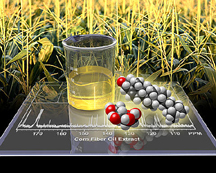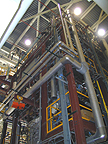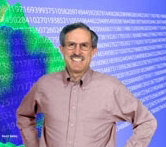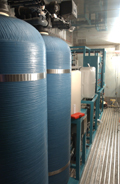Research
Highlights...
|
 |
| Number 131 |
April 28, 2003 |
|
PNNL thinks small to power today's electronic soldier
 |
|
Milli-Watt System Fuel Processor |
On the battlefield, having a reliable source of power to operate the
advanced electronic devices a soldier carries is essential. But
today's heavy and cumbersome batteries fall short in satisfying
the military's needs. Researchers at DOE's Pacific
Northwest National Laboratory have developed the smallest
power system yet. The catalytic fuel processing reactor system
provides a low-watt power source for hand-held wireless equipment,
sensors and other small but essential devices required by today's
troops. The power system is about the size of a cigarette lighter
and converts liquid fuel to electricity via a microscale fuel
processor coupled with a microscale fuel cell developed by Case
Western Reserve University in Ohio. An integral part of the system
is PNNL's revolutionary fuel reformer, which enables the system
to convert fuel and water into hydrogen-rich gas. The fuel cell
then generates electricity by converting hydrogen and oxygen from
the air into electrical power and clean water.
[Geoff Harvey, 509/372-6083,
geoffrey.harvey@pnl.gov]
|
|
NREL highlights leading
utility Green Power programs
DOE's National Renewable Energy Laboratory
recently released its annual ranking of leading utility "green
pricing" programs that allow consumers the choice of supporting
additional electrical production from renewable resources such
as solar and wind. More than 300 utilities in 32 states now offer
these programs. Ranked by sales of green power, the green pricing
program of Austin (Texas) Energy is first in the nation, followed
by Sacramento Municipal Utility District, Xcel Energy (Colo.),
the Los Angeles Department of Water and Power (LADWP), and Portland
General Electric. Visit the Website
for additional rankings.
[Sarah
Holmes Barba, 303/275-3023,
sarah_barba@nrel.gov]
|
|
Thin-film modules break
world record for efficiency
In an effort to increase the conversion efficiency and reliability
of thin film modules as well as lower the cost of the technology,
researchers at Shell Solar and the National
Renewable Energy Laboratory's National Center for Photovoltaics
(NCPV) recently set a world
record for a thin-film copper indium gallium diselenide-based power
module. The thin-film module reached an efficiency of 12.8 percent
and was developed with support from the Department of Energy and
the NCPV's Thin Film Photovoltaic Partnership program. Thin-film
modules have the potential to reduce the cost of solar electricity
and provide a wide range of new photovoltaic products.
[Sarah
Holmes Barba, 303/275-3023,
sarah_barba@nrel.gov]
|
|
FRICON takes the rub
out of nanotech
Loss of energy and efficiency because of friction costs the economy
billions of dollars annually. With the rapid development of nanotechnology,
a new approach to controlling friction was urgently needed. Researchers
from the Center for Engineering
Science Advanced Research at DOE's Oak
Ridge National Laboratory have developed FRICON, an extremely
efficient, fast and robust control scheme. FRICON's efficiency
is not limited to nanodevices and microelectromechanical systems—the
method can be implemented on systems of any size. Because friction
is omnipresent in scientific, engineering and technological applications,
the scheme has broad relevance and applicability.
[Marty
Goolsby, 865/574-4166,
goolsbymb@ornl.gov]
|
|
Profitable to the very
last drop
 |
| Researchers
at Pacific Northwest National Laboratory are working to develop
an economic process for the separation of corn fiber into
its core building blocks. |
Increasing the high-value yield from crops is an ongoing challenge
for the nation's farmers, agricultural processors and the bioproducts
industry. Researchers from DOE's Pacific
Northwest National Laboratory, Archer Daniels Midland and the
National Corn Growers Association have entered the pilot phase of
a project to define a new process for economical recovery of highly
marketable components from corn fiber. The team's experts in applied
and fundamental sciences and advanced process engineering are taking
a holistic approach to the project. They have "disassembled" the
entire corn fiber stream into its primary components—carbohydrates,
oils, and protein—and developed recovery processes that maximize
product yield from each component. The new technology could reduce
petroleum imports by significantly improving supplies of valuable
industrial chemicals and transportation fuels, create a higher value
animal feedstock and boost the overall value of feed grains.
[Kathryn
Lang, 509/375-3837,
Kathryn.Lang@pnl.gov]
|
|
New NETL facility tests
CO2 capture
 |
| MCCF
Test Stand The test stand's combustor can burn coal, natural
gas, or a combination of both to produce a flue gas to test
promising CO2 separation and capture technologies. |
To accelerate DOE's evaluation of viable options to reduce CO2
emissions from fossil-fuel-based power plants, DOE's National
Energy Technology Laboratory (NETL) has designed and constructed
a modular, versatile facility on site to test new ideas for CO2
capture and sequestration. The Modular
Carbon Dioxide Capture Facility (MCCF) can operate on coal,
natural gas, or both to simulate coal-fired combustion processes.
It can be used to evaluate promising CO2 capture and
separation processes, while addressing DOE's
Carbon Sequestration Program goal to develop efficient, cost-effective
CO2 disposal systems. By offering its MCCF to the research
community at-large, NETL's
Carbon Sequestration Science Focus Area welcomes partnerships
with stakeholders interested in capture/separation techniques within
sequestration scenarios.
[David
J. Anna, 412/386-4646,
anna@netl.doe.gov]
|
|
Real
mathematicians really
do compute
 |
|
David
Bailey
|
David Bailey is chief technologist for DOE's National Energy
Research Scientific Computing Center (NERSC).
But when he and Canadian mathematician Jonathan Borwein began
collaborating in 1985, the attitude was "real mathematicians
don't compute."
Bailey and Borwein's new book, Experimentation in Mathematics,
aims at a younger generation of mathematicians who use computer-powered
"experimental mathematics" to uncover surprising results. The
May issue of Scientific
American suggests the book, not due until September
from publisher A K Peters, Ltd., is already eagerly anticipated.
Bailey and his colleagues' own experimental discoveries include
a formula for finding
any binary digit of pi without calculating the digits preceding
it and a recent proof that an entire class of fundamental constants
is "normal."
Born in Provo, Utah, Bailey's role models were his neighbors,
mathematicians at Brigham Young University. While an undergraduate
there, his precocity landed him a job programming computers
to do physics. "I cut my teeth on computers at BYU," he says.
His computing experience kept him employed after his Stanford
doctorate in 1976, a time when the market for mathematicians
was so bad that Ph.D.s were driving cabs.
On moving to NASA's Ames Research Center in 1984, he was promptly
assigned to "shake down" NASA's first Cray-2 supercomputer.
To test how well it could sustain a long calculation, he computed
the first 29 million digits of pi on two of its four processors—which
came up with two different answers. It took nine months to get
the bugs out.
At NERSC, Bailey tests supercomputer performance and develops
algorithms for scientific calculations. His love for the fundamentals
is alive and well.
"To this day I live in two worlds, theoretical math and scientific
computing," he says. "I'm trying to marry these two by applying
advanced computing to problems in pure mathematics. Experimental
mathematics is the outcome."
Submitted by DOE's Lawrence Berkeley
National Laboratory
|
|





